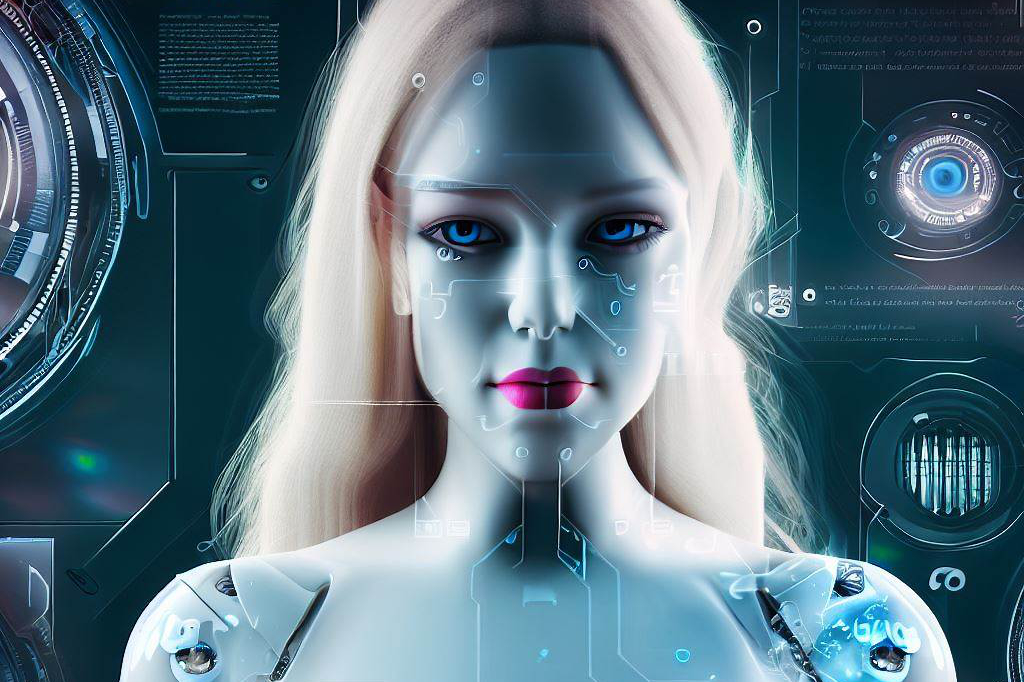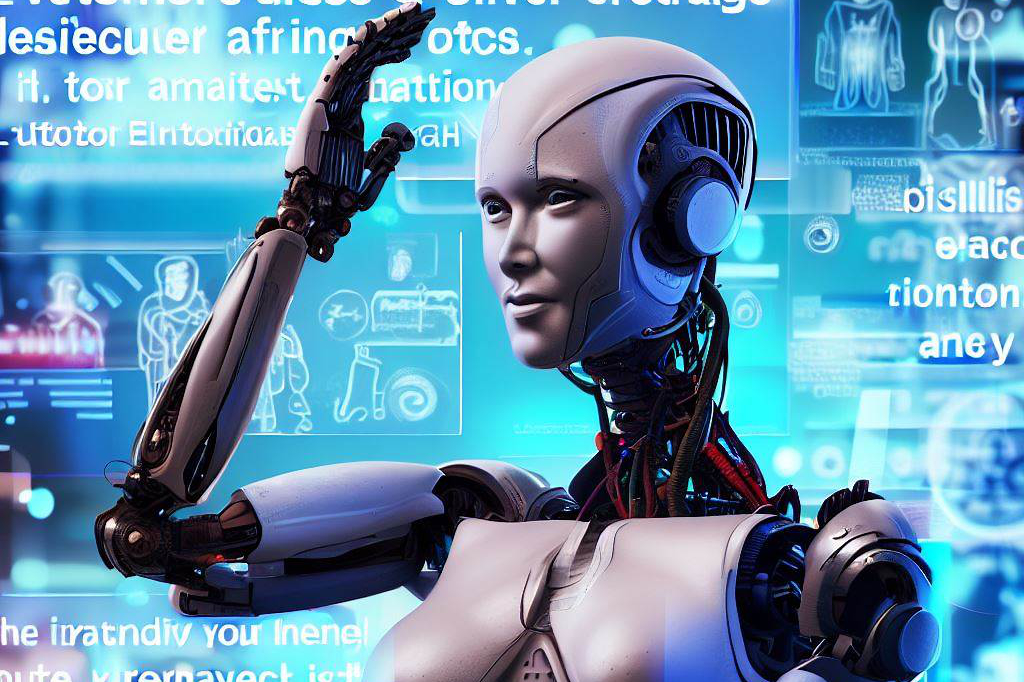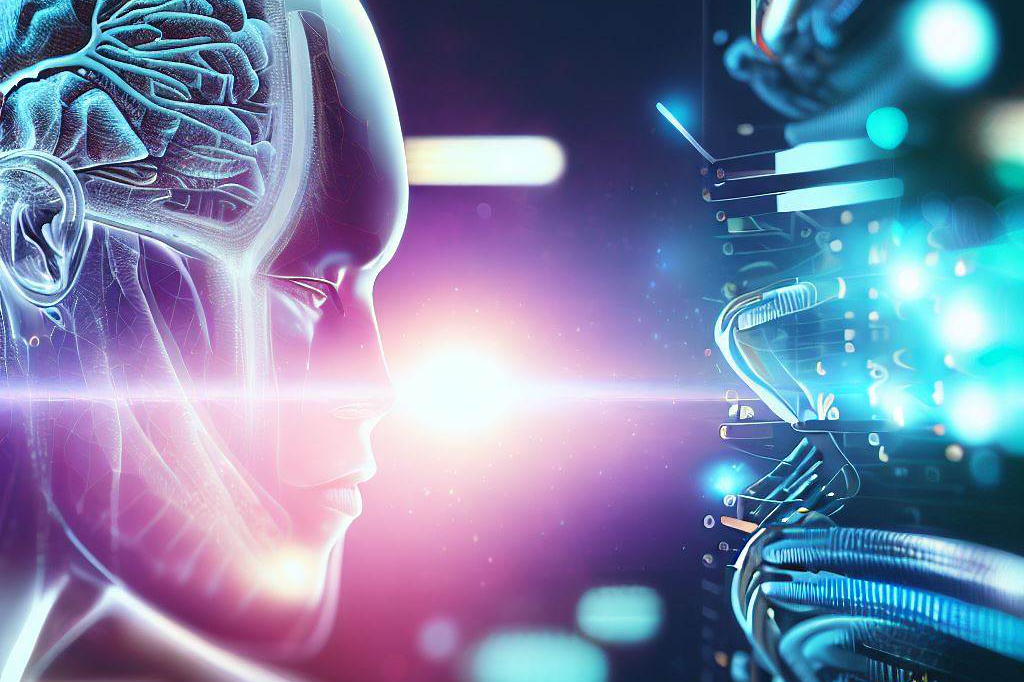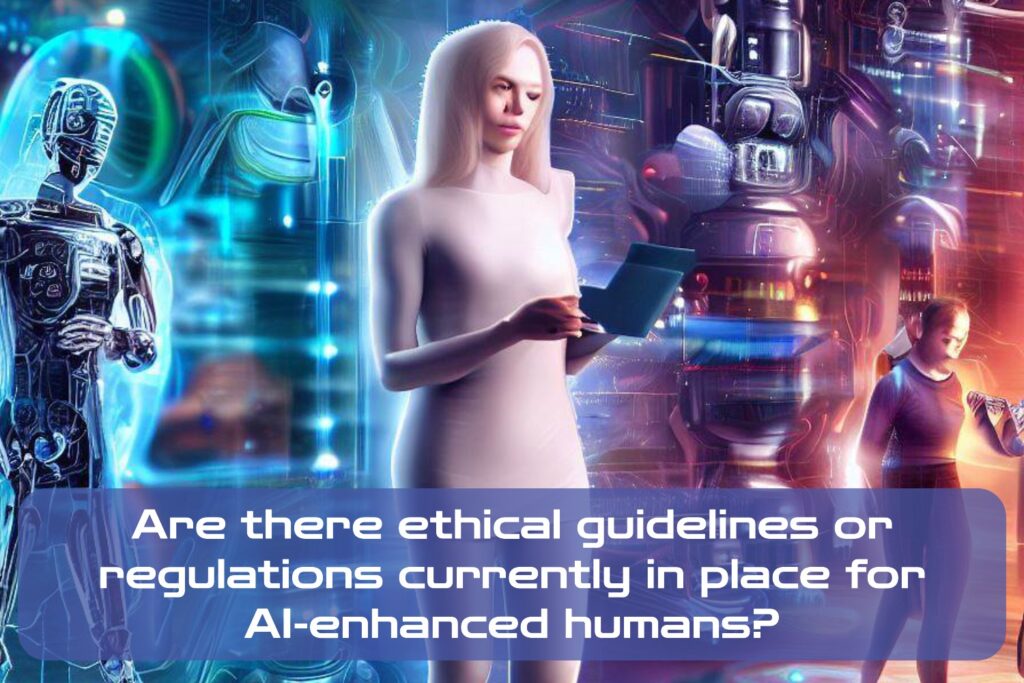In recent years, there has been a significant development in Artificial Intelligence (AI) technology which has led to the development of AI-enhanced humans. These are humans who have had their physical or cognitive abilities enhanced through the use of AI technology.
This may include brain-computer interfaces, gene editing, or other forms of technological enhancements. The idea of AI-enhanced humans may sound like something out of a sci-fi movie, but it is becoming increasingly common.
Scientists and researchers are tapping into the vast potential offered by AI to improve human performance and quality of life. The benefits range from medical treatments and rehabilitation to enhancing physical strength and cognitive abilities.
Why Ethical Guidelines and Regulations are Important
While these advancements have many potential benefits, they also present ethical dilemmas that need to be addressed. The question arises: what ethical guidelines or regulations exist for these newly enhanced individuals?
There is currently no clear set of guidelines for such individuals, which leaves them vulnerable to exploitation or mistreatment. This article aims to explore the current state of ethical guidelines and regulations for AI-enhanced humans.
In doing so, we will examine the various ethical dilemmas posed by this evolving field and discuss how they can be addressed through effective guidelines and regulations. It is imperative that we consider these issues as we move forward with this promising technology to ensure that we do not leave anyone behind in our progress towards a better future.
Ethical Guidelines for AI-Enhanced Humans

Definition and Explanation of Ethical Guidelines
Ethical guidelines are a set of rules that provide a framework for responsible and ethical behavior. They help ensure that the use of technology is guided by principles that respect individuals’ dignity, privacy, and basic human rights. In the context of AI-enhanced humans, ethical guidelines aim to prevent the misuse or abuse of technology while also promoting its responsible use.
Current Ethical Guidelines for AI-Enhanced Humans
There are various organizations and bodies that have created ethical guidelines for the use of AI-enhanced humans. The IEEE Global Initiative on Ethics of Autonomous and Intelligent Systems has developed ethical principles for artificial intelligence (AI) systems, which include transparency, accountability, and safety.
The European Union’s General Data Protection Regulation (GDPR) has also set regulations on how personal data can be collected and used by companies. Examples of current ethical guidelines include transparency in how AI technology is used to avoid secrecy or deception; privacy to protect an individual’s personal information from being accessed without their consent; safety to ensure that any technology used is safe both physically and emotionally; and accountability to make sure individuals or companies responsible for any negative effects.
Discussion on the Effectiveness of Current Guidelines

While current ethical guidelines provide a good starting point, they are neither perfect nor comprehensive enough. Moreover, some organizations have not yet implemented those guidelines into their daily activities despite claiming compliance with them.
The effectiveness of current ethical guidelines depends on several factors such as
- cultural differences between countries regarding what is considered ethical or acceptable behavior;
- resources available to enforce these rules;
- complexity in keeping up with new technologies as they emerge.
Overall we need more collaboration between governments and private organizations worldwide if we want effective ethics frameworks in place.
Regulations for AI-Enhanced Humans

Definition and explanation of regulations
Regulations are laws, rules, and policies that are created to manage and control certain aspects of society. In the case of AI-enhanced humans, regulations are designed to protect their rights and ensure their safety as they interact with advanced technology.
Regulations can be implemented at different levels, depending on the specific jurisdiction and the goals of the regulating body. Some regulations may be set by governments or international organizations, while others may be created by private companies or industry groups.
Current regulations for AI-enhanced humans
At present, there is a lack of comprehensive regulatory frameworks specifically tailored to AI-enhanced humans. However, there are some existing laws that apply to these individuals in certain contexts.
For example, in some countries, people with implanted devices such as pacemakers or cochlear implants have legal protections against discrimination in employment and healthcare. Additionally, some international human rights conventions provide protection against abuses related to technological intrusion on an individual’s privacy.
Examples: legal status, human rights, access to technology
Legal status is one key aspect that has been addressed in current regulations for AI-enhanced humans. Different jurisdictions have different definitions of what constitutes a “person” under the law; some argue that enhanced individuals should be granted personhood with corresponding rights and responsibilities.
Human rights violations are another concern when it comes to AI enhancement; since these technologies can affect an individual’s autonomy and privacy, there is a need for clear guidelines regarding their use in order to avoid abuses such as forced implantation or data harvesting without consent. Access to technology is also an important factor; with financial barriers being one major obstacle preventing many people from accessing advanced enhancements.
Effectiveness of current regulations
While current regulations offer some protections for AI-enhanced humans, they are often limited and patchwork in nature. Many countries have yet to address this issue at all, leaving individuals vulnerable to abuse and exploitation.
In addition, there are concerns that existing regulations may not be sufficient to address future advancements in AI enhancement technology, such as brain-computer interfaces or gene editing. As such, there is a need for more comprehensive frameworks that can effectively regulate these emerging technologies while still protecting the rights and autonomy of enhanced individuals.
Ethical Dilemmas in AI Enhancement

The Problem with Discrimination
One of the main ethical dilemmas that arises with the use of AI enhancement is the potential for discrimination. As AI technology becomes more sophisticated and integrated into our society, there is a risk that some individuals or groups may be unfairly advantaged or disadvantaged by its use.
For example, if employers start using AI to make hiring decisions, there is a possibility that certain groups (such as women or people of color) may be discriminated against based on factors like their name or accent that are unrelated to their qualifications for the job.
To address this issue, ethical guidelines and regulations could be put in place to ensure that any algorithms used in decision-making are transparent and free from bias. Additionally, diversity and inclusion should be taken into account when designing and implementing AI technology.
Tackling Inequality
Another concern related to AI-enhanced humans is the potential for increased inequality. As access to these technologies becomes more widespread, there is a risk that those who cannot afford them will be left behind. This has already happened with many other types of technological advancements (such as smartphones and computers), which have created what some refer to as a “digital divide.”
To prevent this from happening with AI enhancement technologies, regulations could be put in place to ensure equitable access for all individuals. Additionally, policymakers could explore ways to make these technologies more affordable and accessible, such as through government subsidies or partnerships between private companies and non-profit organizations.
Preserving Autonomy
One of the key ethical dilemmas associated with AI enhancement is the potential loss of autonomy for those who choose to use these technologies. As we integrate more technology into our bodies and brains, it raises questions about what it means to truly be human.
To preserve autonomy while also reaping the benefits of AI enhancement, ethical guidelines and regulations could be put in place to ensure that individuals are fully informed about the risks and benefits of these technologies before making a decision. Additionally, there should be strict regulations around how these technologies are marketed to consumers, to prevent companies from taking advantage of vulnerable individuals who may not fully understand the implications of using AI enhancement.
Future Implications and Considerations

Potential Advancements in AI Enhancement Technology: Brain-Computer Interfaces
The future of AI-enhanced humans is exciting and full of possibilities. One of the most promising technologies is brain-computer interfaces (BCIs), which allow direct communication between the brain and a computer or other devices, bypassing traditional input methods such as keyboards or touchscreens. BCIs can be used to control prosthetics for people with disabilities, improve cognitive abilities, and even enhance physical performance.
However, the development of BCIs also raises ethical concerns. For example, who will have access to this technology?
Will it create a new class divide between those who can afford to enhance their cognitive abilities and those who cannot? Additionally, there are issues surrounding privacy.
What if someone hacks into your BCI and gains access to your thoughts? As this technology becomes more advanced and widespread, it is essential to establish ethical guidelines and regulations that ensure its benefits are available to everyone without sacrificing privacy or exacerbating existing inequalities.
Potential Advancements in AI Enhancement Technology: Gene Editing
Another area where AI-enhanced humans may see significant progress in the near future is gene editing. With CRISPR-Cas9 technology becoming increasingly sophisticated, it may soon be possible to edit our DNA directly. This could lead to cures for genetic diseases, but also open up new possibilities for enhancing physical or cognitive traits.
However, gene editing raises complex ethical questions about what should be considered natural versus artificial enhancements. If we start tinkering with our genes for non-medical purposes, we risk creating new forms of inequality based on genetic makeup.
It is important that any advancements in gene editing are regulated by ethical guidelines that prioritize safety and equality. Gene editing should not perpetuate harmful stereotypes or discrimination based on genetics.
How Advancements in AI Enhancement Technology Will Impact Current Ethical Guidelines and Regulations

As AI-enhanced humans become more commonplace, we will need to re-evaluate our current ethical guidelines and regulations. For example, the right to privacy may need to be expanded to include protection for personal thoughts if BCIs become more widely used.
Additionally, as new technologies emerge, it may be necessary to create new ethical guidelines or adjust existing ones. We must ensure that all advancements in AI enhancement are developed and used in a responsible manner that benefits society as a whole.
While the future of AI-enhanced humans is full of exciting possibilities, it is crucial that we approach these advancements with careful consideration of their ethical implications. By establishing clear ethical guidelines and regulations now, we can ensure that these technologies benefit everyone without creating new forms of inequality or threatening personal privacy.
Final Thoughts

The use of AI enhancement in humans is a rapidly advancing field that presents a host of ethical concerns. While there are some current ethical guidelines and regulations in place, they often fall short of addressing complex issues such as discrimination and loss of autonomy. It is clear that the continued development and implementation of effective ethical guidelines and regulations is necessary to ensure the responsible use of AI enhancement technology.
Throughout this article, we have discussed the importance of transparency, privacy, safety, and accountability when it comes to AI-enhanced humans. These guidelines should be upheld not just by individuals and organizations developing AI technologies but also by regulatory bodies to ensure compliance across the board.
Furthermore, we have explored some potential ethical dilemmas that may arise with the increasing use of AI enhancement technology. It is crucial that these dilemmas be addressed with thoughtful consideration to avoid exacerbating inequalities or infringing upon human rights.
Moving forward, it is imperative that all stakeholders involved in the development and regulation of AI enhancement technology prioritize the establishment and enforcement of comprehensive ethical guidelines. Only then can we truly harness the benefits of this groundbreaking technology while ensuring its responsible use for generations to come.
FAQ: Ethical Guidelines and Regulations for AI-Enhanced Humans
NOTE:
Guidelines are often just that, and little more, and regulations are often limited in their reach, and individual scope. Please keep this in mind when perusing the FAQs below.
As it stands currently, it is my opinion that local, regional, national, and international laws on this subject are woefully lacking.
Q1: What are AI-enhanced humans?
A1: AI-enhanced humans refer to individuals who have integrated artificial intelligence technologies into their bodies or cognitive systems to enhance their abilities or augment their natural capabilities.
Q2: Are there any ethical guidelines in place for AI-enhanced humans?
A2: Yes, there are ethical guidelines that have been established to govern the development, deployment, and use of AI-enhanced humans. These guidelines aim to ensure responsible and ethical practices within this emerging field.
Q3: What are the key principles behind these ethical guidelines?
A3: The ethical guidelines for AI-enhanced humans generally revolve around principles such as transparency, privacy, safety, accountability, and inclusivity. These principles are crucial for addressing potential risks and promoting responsible use of AI technologies in human augmentation.
Q4: Who develops and enforces these ethical guidelines?
A4: These guidelines are typically developed and enforced by a combination of regulatory bodies, industry associations, research organizations, and legal frameworks. Collaboration among these entities is essential to establishing comprehensive and enforceable guidelines.
Q5: How do these ethical guidelines address privacy concerns?
A5: Privacy concerns are a key consideration in the ethical guidelines for AI-enhanced humans. The guidelines emphasize the need for informed consent and robust data protection measures. They also promote the right to privacy and encourage transparency in data collection, storage, and usage.
Q6: Are there regulations that govern the use of AI-enhanced humans?
A6: Yes, there are regulations in place that govern the use of AI-enhanced humans. These regulations are intended to ensure the responsible and ethical integration of AI technologies into human beings.
Q7: What types of regulations exist for AI-enhanced humans?
A7: The regulations for AI-enhanced humans encompass various aspects, including but not limited to safety standards, data protection, informed consent, liability, and intellectual property rights. These regulations provide a framework for ethical practices and protect the rights and well-being of individuals.
Q8: How do these regulations address safety concerns?
A8: Safety concerns are a top priority in the regulations governing AI-enhanced humans. The regulations mandate rigorous testing, certification, and quality control processes to ensure the safety and reliability of AI technologies used in human augmentation. They also require ongoing monitoring and reporting of safety data.
Q9: Do these regulations cover the potential risks of AI-enhanced humans?
A9: Yes, the regulations aim to address the potential risks associated with AI-enhanced humans. They require risk assessment and management strategies to be in place during the development and deployment of AI technologies in human augmentation. The regulations also outline procedures for addressing any adverse events or unintended consequences.
Q10: How do the ethical guidelines and regulations promote accountability?
A10: The ethical guidelines and regulations for AI-enhanced humans emphasize the importance of accountability. They require clear roles and responsibilities to be defined for all stakeholders involved, including developers, users, regulatory bodies, and healthcare professionals. These guidelines and regulations help ensure that those responsible for the technology are accountable for its proper use and potential consequences.
Q11: Are there any guidelines regarding the equitable distribution of AI-enhanced technologies?
A11: Yes, the ethical guidelines for AI-enhanced humans promote inclusivity and the equitable distribution of AI technologies. They discourage any form of discrimination or unfair access to these technologies and emphasize the importance of providing equal opportunities for everyone, regardless of their socioeconomic background.
Q12: Can these ethical guidelines and regulations adapt to the evolving nature of AI-enhanced humans?
A12: Yes, the ethical guidelines and regulations are designed to be flexible and adapt to the evolving nature of AI-enhanced humans. The field of AI is rapidly advancing, and these guidelines and regulations aim to keep pace with technological developments while ensuring ethical and responsible practices.

C M, a seasoned editor, journalist, and consultant, is deeply fascinated by the convergence of technology, space, and the future of humanity.
With a particular interest in transhumanism, futurology, and the philosophical and ethical dimensions of these domains, C M serves as the lead contributor to TranscendSphere and SpaceSpotlight.
When not penning insightful articles on these rapidly evolving fields, C M indulges in their love for podcasts and books, proudly embracing their status as a ‘Happy Nerd Extraordinaire!’





